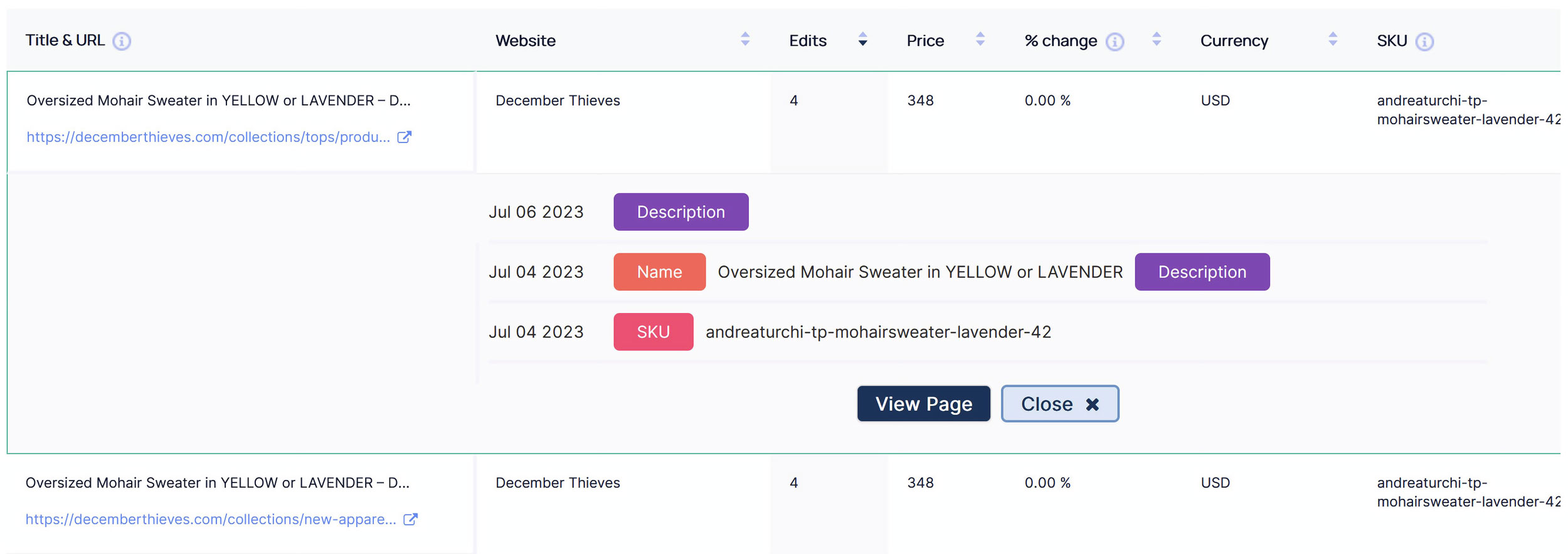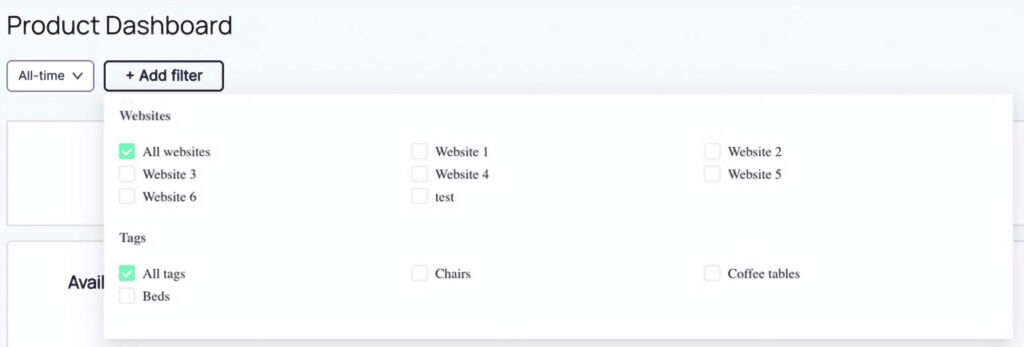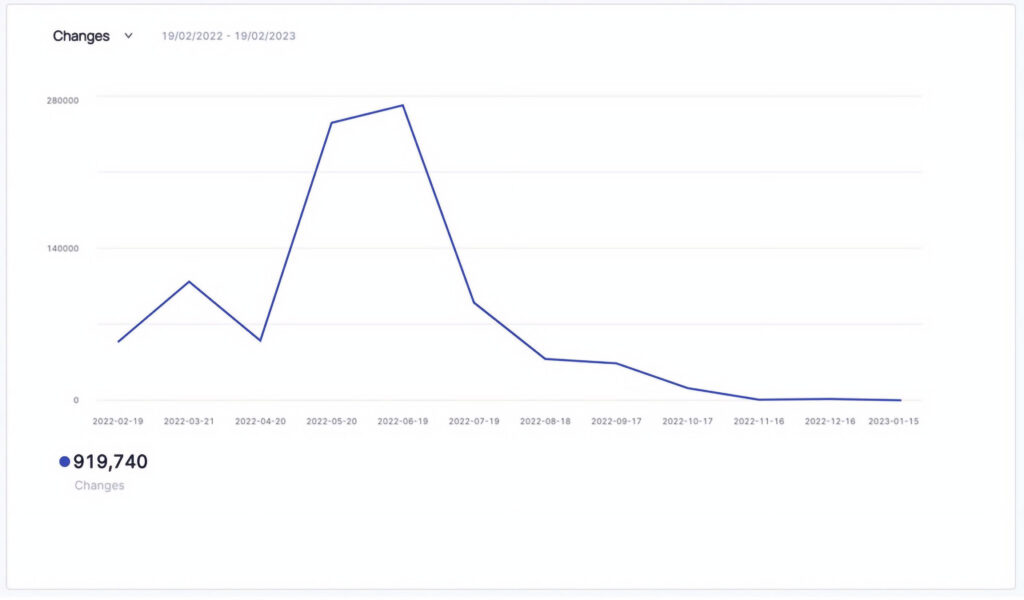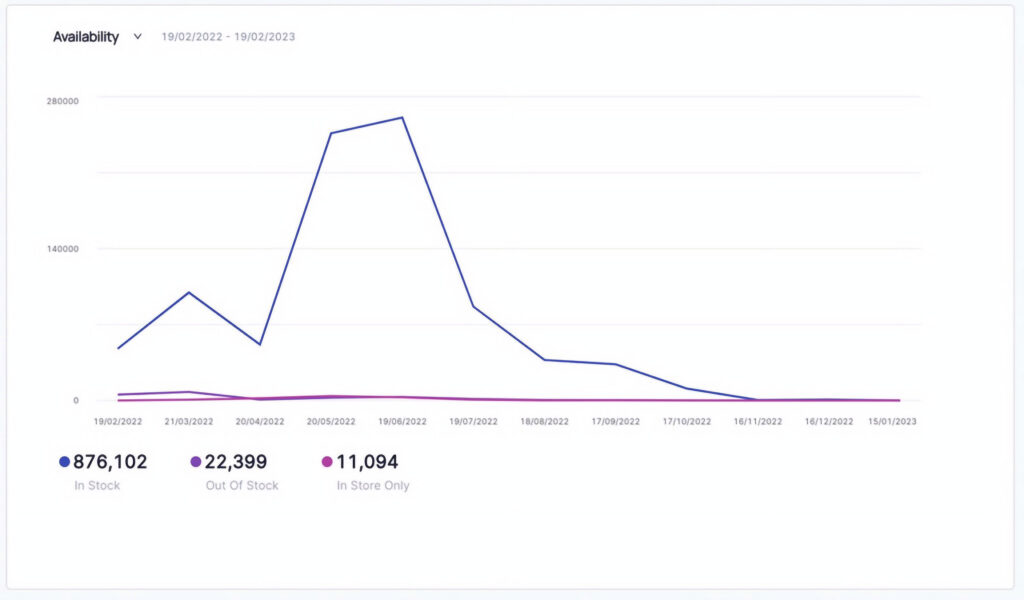Price Monitoring
Price monitoring should have always been this simple. DataNoodle tracks eCommerce pricing changes and product availability, allowing you to keep updated on market movements and make data-driven decisions. The best part? It’s all automatic, meaning you can do away with (horrible!) manual price monitoring and focus on the things that matter.
You can monitor websites that you control, as well as those belonging to your competitors. You can even integrate your Google Analytics with DataNoodle’s eCommerce analytics, giving you tasty insights into what’s really driving your sales and conversions.
Read on to learn how set up and use price monitoring and product availability tracking with DataNoodle.
Product Dashboard overview
The Product Dashboard is the first thing you’ll see when you click into the Products tab inside your DataNoodle account. It provides a snapshot of all the eCommerce products currently being tracked inside your Ecosystem. (Don’t have an Ecosystem set up yet? Learn how – it’s super easy!)
Here’s what you’ll find as you go down the page.
DATE SELECTOR
Adjust the date range for your data using the dropdown menu. The date range selected will affect the data displayed on the rest of the page.
Products filters selector
Click the + Add Filter button to apply filters to view data on specific websites tracked within your Ecosystem. For example, you can select just your website, or just your competitors’ websites, or any combination you want.
You can also select one or more vertical tags to filter by data segments of certain products. For example, if you’re in the furniture industry, you might want to view only the products tagged as “Chairs”.
Here on the Products tab, filtering by a vertical tag like “Chairs” will bring up product-specific pricing and availability changes for those tagged products.
Whereas over on the Website tracking tab, you’ll see content-specific changes at the HTML level. For instance, if content inside a main heading <h1> or link <a> element is added, updated, or removed.
Product Scoreboard
The scoreboard is an overview of three tracked metrics: Total products, Total product value, and Total in stock. Note that regardless of the date range, these numbers always reflect the current eCommerce product totals within your vertical tag parameters, or within the entire Ecosystem if no vertical tags are selected.
- Total products: All products DataNoodle has detected and is currently tracking.
- Total product value: The total value of merchandise tracked, calculated by totaling the prices of all products currently in stock. Note that this figure is dependent on whether a product’s structured data reflects stock availability and price values. Products that are missing this structured data will not be reflected in the total.
- Total in stock: All products that are currently in stock.
Changes & Availability graphs
Changes graph
The Changes graph plots the total number of structured data changes that occurred within your selected date range and vertical tag parameters. One page can represent more than one change, as single pages usually have multiple structured data points.
Availability graph
Use the dropdown menu to switch your view from Changes to Availability, and you’ll see another line graph that plots the total number of in stock products.
Depending on how you set up your Ecosystem and the structured data implemented by the websites you’re tracking, this graph displays up to ten different data lines:
- In Stock: Products available for purchase.
- Out of Stock: Products unavailable for purchase.
- Online Only: Products available for online purchase only.
- In Store Only: Products available for offline purchase only.
- Back Order: Products available for backorder.
- Discontinued: Products unavailable due to discontinuation.
- Sold Out: Products unavailable due to being sold out.
- Limited Availability: Products with limited availability.
- Pre Order: Products available for preordering (to be delivered once the product is publicly available).
- Pre Sale: Products available for presale (to be delivered before the product is publicly available).
Product Data overview
Where the Product Dashboard provides the broad strokes of product pricing and availability changes, the Product Data table is where you can dig deep into data analysis for specific product pages.
Table Rows

Click on any data row in the table to open a quick overview of up to the last five days of changes for that product page. To see more, click the View Page button.
You can sort the order of data rows by clicking the up/down arrows next to the column headers. The sorting options are:
- Website – Name of website as set up in your Ecosystem (forward or reverse alphabetical).
- Edits – Number of structured data changes detected (high to low or low to high).
- Price – Numerical price value (high to low or low to high).
- % Change – Percentage change of current price from previous price (high to low or low to high).
- Currency – Name of currency (forward or reverse alphabetical).
- SKU – SKU text value (forward or reverse alphabetical).
- Last edited – Date of the last detected change (most or least recent).
- Availability – Availability status of InStock or OutofStock (forward or reverse alphabetical).
- Duration – Days the availability value has been the same (forward or reverse numerical).
- Discovered – Date that DataNoodle first crawled the page (most or least recent).
- Brand – Brand name as taken from the page’s structured data (forward or reverse alphabetical).
Table Filters

Use our advanced filters to slice and dice your data. Apply different search modes to expand or narrow your results. To reset a filter after making a search, click the refresh icon beside it.
SKU
Search and filter by manufacturer SKU to find a specific product sold across one or more online stores.
- Is – Returns an exact match. Enter text with this search mode if you know the exact SKU you’re looking for.
- Contains – This mode returns results for entered text found in any part of the SKU.
- Starts With – Searching for only the first part of the SKU can uncover variations for that product (different sizes, colors, etc.).
- Ends With – Returns all SKUs that end with the entered text.
Price
Adjust the price range to uncover luxury, premium, budget, and discounted products.
- Over – Returns all products over the entered price.
- Under – Returns all products under the entered price.
- Between – Returns all products within an entered price range.
Title
Title here refers to the meta data title of a web page. In Google’s search results, a web page title is shown as the blue link that you click to visit that page. Titles often contain keywords, to increase the chance of appearing in Google’s results for those keyword searches.
You can also see the title of a web page by hovering your mouse over its browser tab. For example, the title for this page you’re on right now is “DataNoodle: Price Monitoring Tool – Do Data Right”.
- Is – Returns an exact match for the entered page title text.
- Contains – Returns pages with the entered text in any position within the title.
- Starts With – Returns pages with titles that start with the entered text.
- Ends With – Returns pages with titles that end with the entered text.
URL
This filter narrows results by URL (web page address). For example, the URL of this page is https://datanoodle.com/features/price-monitoring/.
- Is – Returns the result for an exact URL.
- Contains – Returns URLs that partially match the entered text. Can be useful for finding product pages within a certain category. For instance, entering “towel” could return results like https://examplestore.com/products/fluffy-red-towel.
- Starts With – Returns URLs that start with the entered text. Note that you must enter the entire beginning of the URL to get results, including the http:// or https:// or www prefixes.
- Ends With – Returns URLs that end with the entered text.
Availability
Filter on product availability status.
- In Stock – Shows products in stock and available for purchase.
- Out Of Stock – Shows products out of stock and unavailable for purchase.
- Online Only: Shows products available for online purchase only.
- In Store Only: Shows products available for offline purchase only.
- Back Order: Shows products available for backorder.
- Discontinued: Shows products unavailable due to discontinuation.
- Sold Out: Shows products unavailable due to being sold out.
- Limited Availability: Shows products with limited availability.
- Pre Order: Shows products available for preordering (to be delivered once the product is publicly available).
- Pre Sale: Shows products available for presale (to be delivered before the product is publicly available).
Ready to up your price monitoring and product tracking game?




